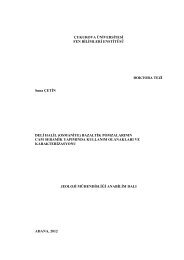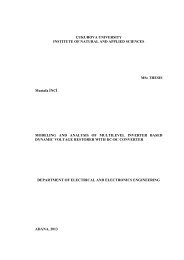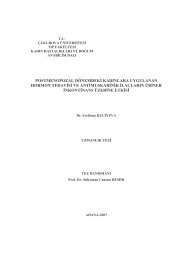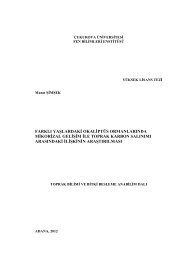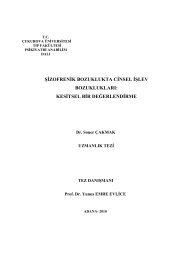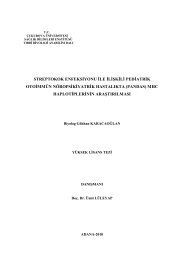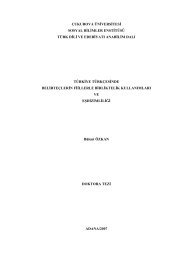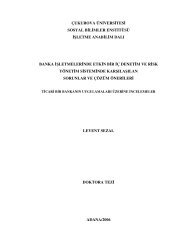ekstremite kırık ve/veya çıkık tedavisi için kapalı redüksiyon yapılan ...
ekstremite kırık ve/veya çıkık tedavisi için kapalı redüksiyon yapılan ...
ekstremite kırık ve/veya çıkık tedavisi için kapalı redüksiyon yapılan ...
Create successful ePaper yourself
Turn your PDF publications into a flip-book with our unique Google optimized e-Paper software.
ABSTRACT<br />
The Comparison of Sedati<strong>ve</strong> Effects of Ketamine and Etomidate for the Reduction<br />
of Children with Limb Fracture/Joint Dislocation<br />
Introduction: The efficient and safe relief of pain, anxiety and stress of children with<br />
limb fractures/joint dislocations is essential for initial evaluation and proper treatment in<br />
the emergency department.<br />
Aim: The goal of our study was to compare the induction and reco<strong>ve</strong>ry times, and<br />
emergency department stay duration of children needed closed reduction for limb<br />
fracture/joint dislocation who were sedated with etomidate or ketamine. We also aimed<br />
to evaluate the procedural success and side effects of the agents, the satisfaction le<strong>ve</strong>ls<br />
of patients’, parents’ and the physicians’.<br />
Materials and Methods: This study was performed as a prospecti<strong>ve</strong>, randomized and<br />
blinded clinical study in 7-18 years old aged 44 healthy children with seperated limb<br />
fractures/joint dislocations in Pediatric Emergency Unit of Cukurova Uni<strong>ve</strong>rsity School<br />
of Medicine between December 2005 and October 2007. The patients were divided into<br />
two groups, one recei<strong>ve</strong>d etomidate+fentanyl while other recei<strong>ve</strong>d ketamine for<br />
procedural sedation. The induction and reco<strong>ve</strong>ry times of the agents, emergency<br />
department stay durations and vital signs and Ramsay sedation scores of patients before,<br />
during and after sedation procedure were measured. Side effects and satisfaction le<strong>ve</strong>ls<br />
of the patients’, parents’ and the physicians’ were evaluated by a questionnaire.<br />
Results: The mean induction time in minutes in Group 1 was 4,3±1,0 and 2,2±1,6 in<br />
Group 2 (p=0,00), where mean reco<strong>ve</strong>ry time was 15,8±7,7 minutes in Group 1 and<br />
20,7±10,8 minutes in Group 2. The mean of emergency department stay duration was<br />
145,5±63,3 minutes in Group 1 and 196,5±141,6 minutes in Group 2. Frequency of side<br />
effects was 37,5% in Group 1 and 25,0% in Group 2. Children sedated with etomidate<br />
complained less pain (p=0,042), and patients and parents were more satisfied. (p=0,020<br />
and p=0,019).<br />
Conclusions: The induction time with ketamine was shorter than with etomidate but<br />
reco<strong>ve</strong>ry times, emergency department stay durations and side effect frequencies were<br />
similar in both groups. Etomidate and ketamine are both safe for procedural sedation of<br />
children in the emergency department.<br />
Keywords: Children, closed reduction, sedation, etomidate, ketamine<br />
ix



